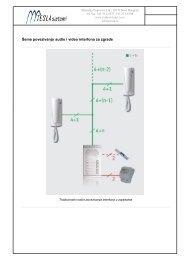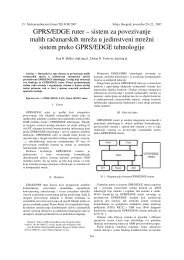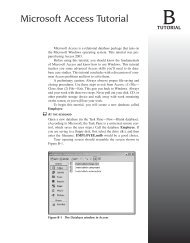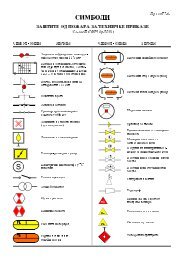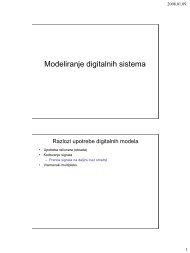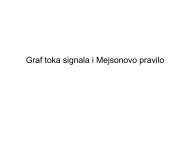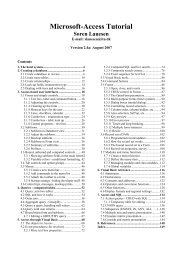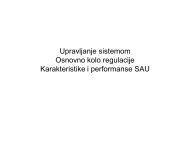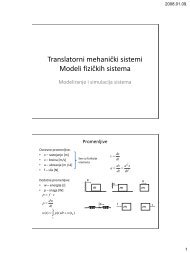Racunarske mreze
Racunarske mreze
Racunarske mreze
You also want an ePaper? Increase the reach of your titles
YUMPU automatically turns print PDFs into web optimized ePapers that Google loves.
Raunarske mreže e i<br />
komunikacije<br />
(laboratorijske vježbe)<br />
Dejan Abazovi<br />
e-Mail: dejoa@ac.me
Plan i program<br />
• Ukupno 24 školska asa<br />
• 4 vježbe po 6 asova<br />
• Zadnja dva asa, u ciklusu od 6,<br />
testiranje-samostalan rad<br />
• Prisustvovanje obavezno
Raunarske mreže<br />
- Tipovi raunarskih mreža<br />
LAN - Local Area Network<br />
(manji prostori, tipino zgrada i sl.)<br />
MAN - Metropolitan Area Network<br />
(više LAN-ova, npr. na teritoriji grada ili sl.)<br />
WAN - Wide Area Network<br />
(geografski udaljena podruja)<br />
- Kategorije raunarskih mreža<br />
Server based<br />
Peer-to-peer
Principi funkcionisanja<br />
raunarskih mreza<br />
Circuit Switching (komutacija kola) - uspostavljanje fizikog kola sa<br />
rezervisanim propusnim opsegom (POTS - Plain Old Telephone<br />
Service ili Post Office Telephone System)<br />
In telecommunications, a circuit switching network is one that establishes a fixed bandwidth<br />
circuit (or channel) between nodes and terminals before the users may communicate, as if the<br />
nodes were physically connected with an electrical circuit. The bit delay is constant during the<br />
connection, as opposed to packet switching, where packet queues may cause varying delay.<br />
Packet Switching (komutacija paketa) - nema fizike trajne komunikacije<br />
izmedju krajeva i svaki paket može da ide i razliitim putem (WAN)<br />
Packet switching is a communications paradigm in which packets (discrete blocks of data) are<br />
routed between nodes over data links shared with other traffic. In each network node, packets are<br />
queued or buffered, resulting in variable delay. This contrasts with the other principal paradigm,<br />
circuit switching, which sets up a limited number of constant bit rate and constant delay<br />
connections between nodes for their exclusive use for the duration of the communication.
Mrežne topologija<br />
• Bus<br />
• Prsten i dvostruki prste (Dual Ring)<br />
• Star - topologija zvijezde<br />
• Extended star - proširena zvijezda<br />
• Topologija drveta<br />
• Mesh<br />
• Neregularna topologija<br />
• elijska topologija
n(n-1)/2
OSI referentni model<br />
You should be familiar with the OSI model,<br />
because it is the most widely used method<br />
for talking about network communications.<br />
The OSI model:<br />
• Provides a standard for hardware<br />
development<br />
• Allows for modular software development<br />
• Speeds development of new technology<br />
Open System Interconnection
Konektor RJ-45, utinice i<br />
Patch panel (UTP i STP)
Ethernet Architecture Facts<br />
Topology<br />
Media<br />
Access<br />
Method<br />
Physical topologies--bus, star, cascading star<br />
Logical topology--bus (physical bus, logical bus; physical star, logical bus), star (physical star, logical star)<br />
1.CSMA/CD--Carrier Sense, Multiple Access/Collision Detection (contention). Devices use the following process to<br />
send data. Because all devices have equal access to the transmission media (multiple access), a device with data<br />
to send first listens to the transmission medium to determine if it is free (carrier sense).<br />
2.If it is not free, the device waits a random time and listens again to the transmission medium. When it is free, the<br />
device transmits its message.<br />
3.If two devices transmit at the same time, a collision occurs. The sending devices detect the collision (collision<br />
detection) and send a jam signal.<br />
4.Both devices wait a random length of time before attempting to resend the original message (called backoff).<br />
Transmissi<br />
on Media<br />
Frame<br />
Type<br />
Physical<br />
Address<br />
•Thick coaxial, thin coaxial, twisted-pair, fiber-optic<br />
The most common Ethernet implementations use unshielded twisted-pair cables (UTP). Each cable consists of<br />
eight wires, twisted into four pairs. UTP cables are classified by categories: Cat3, rated up to 10 Mbps<br />
•Cat4, rated up to 16 Mbps<br />
•Cat5, rated up to 100 Mbps<br />
•Cat5e, rated up to 1,000 Mbps (gigabit)<br />
UTP cables are connected with RJ-45 connectors.<br />
•Frame size = 64 to 1518 bytes (this is the same for all Ethernet standards)<br />
Four frame types are supported: Ethernet 802.3--This frame type is the original Ethernet frame type.<br />
•Ethernet 802.2--This frame type accommodates standards set by the IEEE 802.2 committee related to the logical<br />
link control (LLC) sublayer. It is a more current frame type than 802.3.<br />
•Ethernet II--This frame type provides the ability to use TCP/IP as a transport/network layer protocol. Other<br />
Ethernet frame types operate strictly with IPX/SPX as a transport/network layer protocol.<br />
•Ethernet SNAP--This frame type (SubNetwork Address Protocol) is an enhanced version of Ethernet 802.2 that<br />
allows for greater compatibility with other network architectures such as Token Ring. This frame type also supports<br />
TCP/IP.<br />
The MAC address (also called the burned-in address) is used as the Data Link layer physical device address. The<br />
MAC address is a 12-digit hexadecimal number. Each digit ranges from 0-9 or A-F.<br />
The MAC address FFFFFFFFFFFF is the broadcast address. Packets addressed to the broadcast address will be<br />
processed by all devices.
Ethernet Standards<br />
Category Standard Bandwidth Cable Type Maximum Segment Length<br />
Ethernet<br />
Fast Ethernet<br />
10Base5 10 Mbps Coaxial (thicknet) 500 meters<br />
10Base2 10 Mbps Coaxial (thinnet) 185 meters<br />
10BaseT<br />
100BaseTX<br />
100BaseT4<br />
100BaseFX<br />
Bandwidth - jedinica informacije (bit) u jedinici vremena<br />
sekunda), bps (brzina toka, širina propusnog<br />
opsega)<br />
10 Mbps (half duplex)<br />
20 Mbps (full duplex)<br />
100 Mbps (half duplex)<br />
200 Mbps (full duplex)<br />
100 Mbps (half duplex)<br />
200 Mbps (full duplex)<br />
100 Mbps (half duplex)<br />
200 Mbps (full duplex)<br />
Twisted pair (Cat3, 4, or<br />
5)<br />
Twisted pair (Cat5)<br />
Twisted pair (Cat5)<br />
Fiber optic<br />
100 meters<br />
100 meters<br />
100 meters<br />
412 meters (half duplex<br />
multimode cable)<br />
2,000 meters (full duplex<br />
singlemode cable)<br />
1000BaseSX<br />
(short)<br />
1,000 Mbps (half duplex)<br />
2,000 Mbps (full duplex)<br />
Fiber optic<br />
220 to 550 meters depending on<br />
cable quality<br />
Gigabit<br />
Ethernet<br />
1000BaseLX (long)<br />
1000BaseCX (short<br />
copper)<br />
1,000 Mbps (half duplex)<br />
2,000 Mbps (full duplex)<br />
1,000 Mbps (half duplex)<br />
2,000 Mbps (full duplex)<br />
Fiber optic<br />
Special copper<br />
550 to 5,000 meters depending<br />
on cable quality<br />
25 meters, used within wiring<br />
closets<br />
1000BaseT<br />
1,000 Mbps (half duplex)<br />
2,000 Mbps (full duplex)<br />
Twisted pair (Cat5e)<br />
100 meters
Bandwidth<br />
Bandwidth - jedinica informacije (bit) u jedinici<br />
vremena (sekunda), bps (brzina toka,<br />
propusnog opsega)<br />
širina
Primjeri bandwidthb<br />
andwidth-a i dužine<br />
za<br />
razli<br />
zliite ite tipove medijuma<br />
<br />
<br />
<br />
<br />
<br />
!"#<br />
$ %!<br />
"' %!<br />
*!<br />
<br />
<br />
<br />
<br />
<br />
<br />
<br />
<br />
<br />
(#<br />
<br />
<br />
<br />
<br />
<br />
<br />
<br />
<br />
&<br />
)<br />
+, , "!
Throughput - protok<br />
• Odnosi se na stvarni izmjereni bandwidth<br />
u odredjenom dobu dana i upotrebom<br />
odredjenih Internet ruta pri prenosu<br />
odredejnog fajla<br />
• Glavni faktor u analizi mrežnih<br />
performansi
Bandwidth i Throughput<br />
Faktori koji utiu na širinu propusnog opsega i protoka:<br />
• mrežni uredjaji<br />
• tip podataka koji se prenosi<br />
• topologija mreže<br />
• broj korisnika<br />
• korisniki raunar i tip servera<br />
• zagušenje mrežnog saobraaja
Mrežni uredjaji<br />
Host — mrežni uredjaj direktno povezan na<br />
mrežni segment<br />
printer, raunar, server, FAX, razni tipovi mrežni<br />
komunikacionih uredjaja i sl.
Mrežni adapter - NIC<br />
network interface card<br />
• LAN adapter<br />
• Komunicira sa<br />
mrežom preko serijske<br />
konekcije a sa<br />
raunarom preko<br />
paralelne konekcije<br />
• Zahtjevaju IRQ i I/O<br />
adresu
LAN uredjaji u razliitim<br />
itim<br />
topologijama
Hub<br />
<br />
<br />
<br />
<br />
<br />
Regeneriše signal<br />
Koristi se kao mjesto<br />
koncetracije<br />
Ne filtrira saobraaj<br />
Ne definiše put<br />
podacima<br />
Naziva se i multiport<br />
repeater
Switch<br />
<br />
<br />
<br />
Koriste se kao mjesto<br />
koncentracije<br />
Kombinuju konektivnost<br />
HUB-a i mogunost<br />
regulacije bridge-a<br />
Obezbjedjuju odvojene<br />
puteve za podatke
Ruteri<br />
<br />
<br />
<br />
<br />
Uredjaji za regulisanje toka saobraaja u velikim<br />
mrežama<br />
Donose odluke na osnovu mrežnih adresa<br />
Rade sa paketima (Layer 3 data), odabiraju<br />
najpovoljniji put za podatke<br />
Dvije glavne funkcija: odabir puta i<br />
preusmjeravanje paketa ka najboljoj ruti
Tok podataka kroz LAN<br />
• Gornja tri sloja pripremaju<br />
podatke za prenos kreirajui<br />
prikladan format za prenos<br />
• Transportni sloj kreira<br />
upracljave jedinice podataka<br />
koje se zovu segmenti<br />
• Identifikuje segmente sa<br />
brojem sekvence -sequence<br />
number.
Tok podataka kroz LAN<br />
• Mrežni sloj enkapsulira segmente<br />
u pakete. Mrežni sloj dodaje<br />
odredišnu i izvorišnu adresu,<br />
obino IP, svakom paketu.<br />
• Data link sloj dalje enkapsulira<br />
pakete u okvir (frame) i<br />
identifikuje ih sa izvorišnom i<br />
odredišnom MAC adresom.
Tok podataka kroz LAN<br />
• Fiziki sloj prenosi bitove.<br />
• Pasivni uredjaji - bitovi jednostavno prolaze kroz<br />
takve uredjaje.<br />
• Aktivni uredjaji - obavlja se regeneracija<br />
• Uredjaji sa fizikog nivoa ne analiziraju header-e<br />
enkapsuliranih podataka




